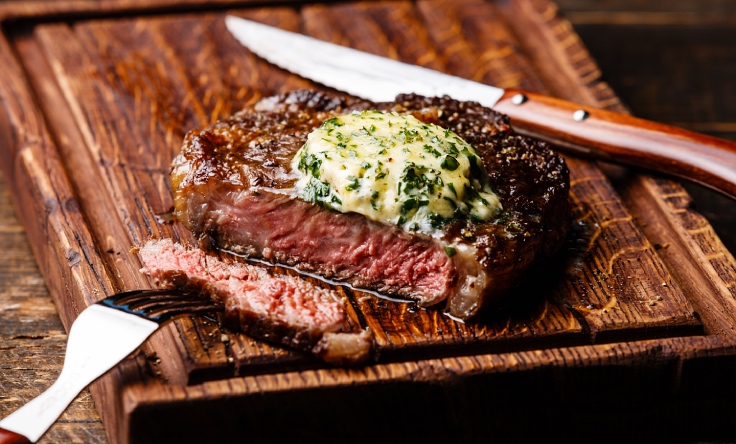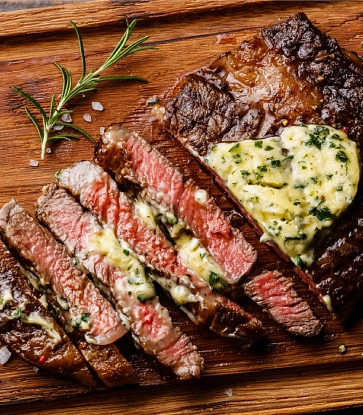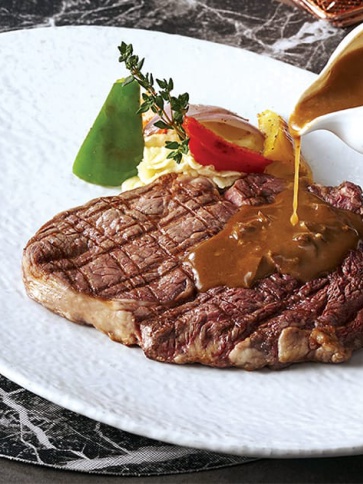As Julia Child said, “the only time to eat diet food is while you're waiting for the steak to cook”. For carnivores, the statement may not be more true.
No matter what we call it, steaks have been around for quite some time. John Ayto writes in The Diner's Dictionary: Word Origins of Food and Drink that the word “steak” originates either from the Old Norse “steikja”, 15th century Scandinavian word “steik”, or Middle English “stickna”. The Oxford English Dictionary records the first use as describing thickly sliced meat, often from an animal’s hind-quarters, meant for roasting, grilling, or frying or for a pie or pudding. The meat could be cow, venison, bull, camel, horse, kangaroo, or other sources, including large fishes such as salmon and swordfish. Meat from pig, lamb, or goat would be a “chop”. References also appear in 15th century cookbooks to “stekys”, which were cuts of beef or venison.

Pairing steaks with fire is an ancient combination found all over the world, from affordable street stalls in South Africa and tiny shacks in Tokyo to the lavish salt-sprinkling performances of Salt Bae in Istanbul.
Whether you enjoy your lean filet mignon, chunky picanha, or carnivorous tomahawk cuts, or you prefer a well-done ribeye slathered in tomato ketchup like Donald Trump (while the chefs curse silently), cooking a perfect steak is an art form. With only a few minutes leeway between blue and well-done, timing is everything.
For those meat lovers missing their steakhouse experiences, we’ve asked two steak masters from Bangkok’s prime restaurants to share their insights on the best cuts, preparations, and techniques. Acclaimed 25-year culinary veteran British Chef Kevin B. Thomson of the prestigious New York Steakhouse (MICHELIN Plate, MICHELIN Guide Thailand 2021) at the JW Marriott Hotel Bangkok and energised New Yorker Steve Doucakis of wood-fire Quince (MICHELIN Plate, MICHELIN Guide Thailand 2021) reveal their tips on how you can prepare the most mouthwatering, succulent steaks at home to show off to your friends.

Why are steaks so appealing?
Chef Thomson: In my opinion, what draws people to steak is the satisfaction and enjoyment of having a wonderful char or crust on the outside, as well as it being seasoned to perfection and cooked to your liking to savour the rich beef flavor and the tender mouthfeel.
Chef Doucakis: I think it's the whole experience. The fire that's needed for a proper grilled steak taps into our primal instincts. When the steak is on the grill, the aroma already is enough to get the mouth watering. The charred fat, the crispy crust from the dark grill marks, and the juicy pink interior that gets unveiled when you slice into it all come together for the steak experience. It's rich with umami and beefy flavour that people crave.

What makes a steak so delicious?
Chef Thomson: First and foremost, we at New York Steakhouse start with a quality product from a quality purveyor. We like to use an aged steak, which has a nice marbling throughout. As to how we handle the steaks, we allow them to come up to room temperature before cooking them on the char grill with the right amount of seasoning. The aim is to get a great char on the outside (the Maillard reaction), and then, of course, resting the steak.
Chef Doucakis: Obviously, the doneness inside is a priority. A proper rare or medium rare steak is ideal in my opinion. Cooking the exterior is just as important -- a deep caramelisation on the outside is what separates a good steak from a great one. Getting a deep char on the soft fat will unlock all of those juices trapped inside and make it incredibly flavourful. Fat is where the flavour and moisture is.
How would you describe your best steak experience?
Chef Thomson: We eat with our nose and our eyes first. You see the rich mahogany finish once the steak is placed in front of you, and your mouth will start to salivate once the gorgeous steak aroma hits your senses. As we eat, we continue to pick up all of the aroma, the slight chew, the tenderness, the juiciness, the meaty flavour, and the rich mouthfeel. This all creates the multi-layered sensory experience of a wonderfully cooked steak.
Chef Doucakis: My favourite steak of all time has to be the Porterhouse at Peter Luger Steakhouse (One MICHELIN Star) in New York. It comes to the table sizzling on the plate, bubbles of the hot butter wafting into the air. It's salty and fatty, with a great charring on the meat. They serve the juiciest steak I've ever seen. The aromas, the sights, the sounds all make the steak an experience. All those things need to come together to make a perfect steak.

What is your favourite cut, and why?
Chef Thomson: The rib-eye is my ultimate steak. It is the most flavourful cut and comes with very rich marbling, which delivers a superior taste when cooked. Just the right amount of fat to meat ratio. Its abundance of marbling makes it a great cut for grilling and slow roasting.
Chef Doucakis: The rib-eye would be my favourite cut for sure. There is plenty of intramuscular fat that makes the steak super juicy and a cap of fat over the top that chars really well on the grill. It's such a flavourful steak.
Why are your steaks special?
Chef Thomson: I believe what separates us is that we do not compromise on the quality of the steaks we offer. Since opening in 1997, we have built our reputation around town as the best steakhouse in Bangkok. We achieve this through consistency, the best quality product, an outstanding culinary team, exceptional front-of-house service, and, of course, the whole New York Steakhouse ambiance that creates another level of dining, giving our guests the New York dining experience.
Chef Doucakis: I think it comes down to the quality and care that we put into doing everything the right way. We start with premium beef, usually wagyu varieties from Australia and Japan, or grass-fed, pasture-raised meat. We season it with plenty of salt and pepper and grill it over coffee wood; it gets so smoky and deep in flavour as it's cooking. We serve it on a huge wooden board with a selection of homemade sauces and a bright salad. Sharp acidity from our homemade mustards combined with the smokiness of the meat is the perfect combo. It's great for special occasions or everyday eating.

What’s the secret to making the perfect steak?
Chef Thomson: Buy the right steak from a butcher, I suggest a rib-eye as that’s my favorite steak. Make sure it’s good quality, like prime, USDA certified, Australian wagyu, or a nice-grass fed steak. After removing from the refrigerator, take about 20 minutes to bring the steak to room temperature. Then pat it dry with some kitchen paper, massage in a little olive oil, and season with sea salt and freshly ground pepper. Heat a heavy frying pan until it’s very hot, but not smoking, then drizzle some olive oil in and leave for a moment. Add the steak and then some garlic, butter, rosemary, and thyme. Sear evenly on each side. Depending on your preference, for a 2-cm thick steak, to cook to: blue, 1 min per side; rare, 1½ mins per side; medium-rare, 2 mins per side; medium, about 2¼ mins per side; well-done, about 4-5 mins per side. Let it rest on a board or warm plate for about 10 mins. Right before serving, quickly flash in a hot pan for 30 seconds. Serve on plates that you warmed in the oven -- not hot, just enough to keep the steak warm. Serve the steak whole with sauce béarnaise on the side.
Chef Doucakis: I would suggest a cast iron pan for home cooking; it's how I cook meat on my day off. The cast iron will retain the heat really well, so when you put in the steak, it can get a proper sear and caramelisation without losing too much heat. Finish with butter, herbs, and garlic in the pan and baste it to add more flavour. Let it rest for five minutes before slicing into it. I promise it's worth the wait. I usually add a bit of Dijon mustard and wine into the pan with the leftover butter to make a quick sauce that's sharp and bright.

What should we watch out for when cooking a steak?
Chef Thomson: Start with the right steak choice. Then make sure you dry the steak with a kitchen towel to keep the oil from splattering. Season correctly, keep an eye on the pan’s temperature, and check cooking time. And always rest the steak for at least 10 mins.
Chef Doucakis: Although high heat from a grill is necessary, if the steak is too close to the coals and flare ups start making a big fire, sprinkle a little water onto the coals to help it die down. Sometimes those flames will make the meat black from soot, which can taste burned, not charred. Controlling the fire is everything. Proper meat resting after cooking is also super important; otherwise, all the juiciness inside will be lost. Patience with letting the meat rest is just as important as the actual cooking.
Hero image, Chef Kevin B. Thomson's image and medium rare steak in order: © Shutterstock, JW Marriott Bangkok, Steve Doucakis/ Quince














